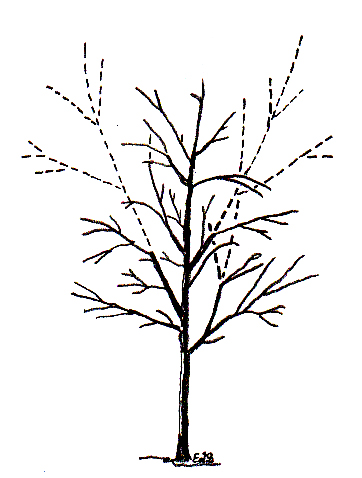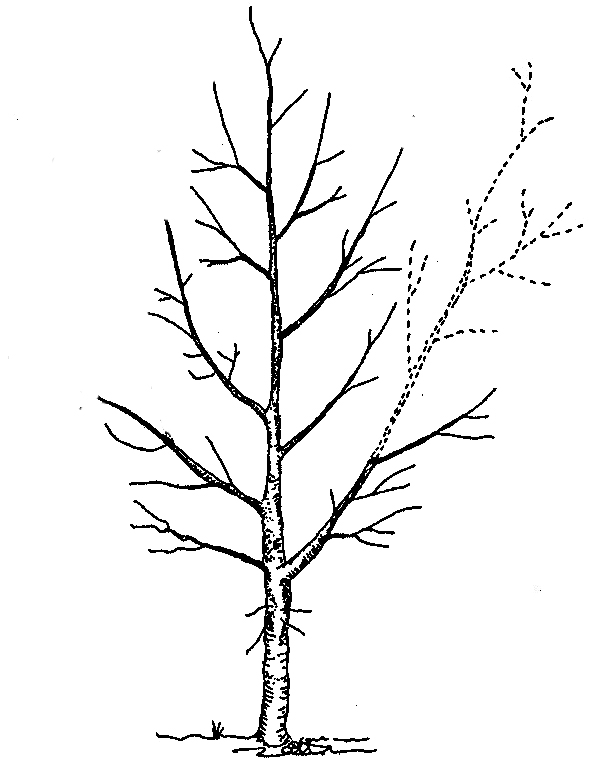Training and pruning trees for strength, clearance, and aesthetics |
Pruning Cue Card: English | Spanish |
Why prune | Tree structure | Pruning
cuts | Prune at planting | Structural pruning |
Sub-standard pruning | Is pruning needed
Raising the crown | Thinning the crown |
Reducing the crown | Pruning home page
 The first priorities when pruning established trees are to reduce conditions in the tree that contribute to weakness, ensure
strong tree structure by guiding future growth, and create clearance. Treating defect by reducing or thinning stems that compete with
the leader, large forked limbs and those with inclusions, or aggressive (fast-growing) or long branches reduces risk by slowing their
growth rate or redistributing mass. Once this structural and clearance pruning is completed, one or more of the other pruning
methods can be applied if needed to complete the job, provided the targeted pruning dose has not been exceeded.
The first priorities when pruning established trees are to reduce conditions in the tree that contribute to weakness, ensure
strong tree structure by guiding future growth, and create clearance. Treating defect by reducing or thinning stems that compete with
the leader, large forked limbs and those with inclusions, or aggressive (fast-growing) or long branches reduces risk by slowing their
growth rate or redistributing mass. Once this structural and clearance pruning is completed, one or more of the other pruning
methods can be applied if needed to complete the job, provided the targeted pruning dose has not been exceeded.
Trees that grow to be large are more structurally sound and cost-effective to maintain when trained with a central dominant leader
that extends 30 feet or more into the crown (see single-leadered tree at right). Trees with branches smaller than half the trunk
diameter, and with branches spaced along the central leader, or trunk are stronger than trees with branches clustered together.
Vigorous, upright branches and stems that compete with the central leader can become weakly attached (top right illustration).
Structural pruning in the landscape aims to develop and maintain the strong central leader structure found in the forest.
 Structural pruning selectively favors a
single, dominant leader by suppressing competing leaders using reduction cuts (left illustration). Reduction cuts shorten stems back
to lateral branches that are at least one-third the diameter of the cut stems. Structural pruning on shade trees that occurs regularly
when the tree is less than about 20 inches trunk diameter establishes strong form early. It is normally performed every few years to
gradually encourage more growth in the selected leader. Structural pruning performed on most tree species that become large at maturity
promotes longevity, decreases future maintenance costs, and reduces conditions in the tree that could place people or property at risk.
All branches and stems should be shorter than the central leader after pruning is completed. Structural pruning selectively favors a
single, dominant leader by suppressing competing leaders using reduction cuts (left illustration). Reduction cuts shorten stems back
to lateral branches that are at least one-third the diameter of the cut stems. Structural pruning on shade trees that occurs regularly
when the tree is less than about 20 inches trunk diameter establishes strong form early. It is normally performed every few years to
gradually encourage more growth in the selected leader. Structural pruning performed on most tree species that become large at maturity
promotes longevity, decreases future maintenance costs, and reduces conditions in the tree that could place people or property at risk.
All branches and stems should be shorter than the central leader after pruning is completed.

 Shortening or removing branches
that are larger than half the trunk diameter (large lower right branch in illustration at right) at planting, and every few years, is
an effective way to maintain a leader. These stems and branches are shortened by cutting back to a live lateral branch. This lateral
branch should be pointed away from the trunk and it should not be growing upright (left illustration). The central
leader should be more visible in the crown center after pruning. Only large-diameter branches need to be pruned because they compete
with the leader and could be weakly attached. Small branches do not need pruning because they will not compete with the leader. Shortening or removing branches
that are larger than half the trunk diameter (large lower right branch in illustration at right) at planting, and every few years, is
an effective way to maintain a leader. These stems and branches are shortened by cutting back to a live lateral branch. This lateral
branch should be pointed away from the trunk and it should not be growing upright (left illustration). The central
leader should be more visible in the crown center after pruning. Only large-diameter branches need to be pruned because they compete
with the leader and could be weakly attached. Small branches do not need pruning because they will not compete with the leader.
|
Structural Pruning Checklist
1. Develop and maintain a central leader.
2. Identify the lowest branch in what will become the permanent crown.
3. Prevent branches below the permanent crown from growing larger than half the trunk diameter.
4. Space main branches along the central leader.
5. Reduce vigorous upright stems back to lateral branches.
Pruning Safety
1. Prune from the ground using proper tools and safety equipment.
2. Do not prune near power lines.
|
The text and illustrations for the pruning section has been adapted from "Illustrated Guide to Pruning, third edition"
2012, Delmar Publishing, Albany, NY. Edward F. Gilman, Ph.D.
|

 The first priorities when pruning established trees are to reduce conditions in the tree that contribute to weakness, ensure
strong tree structure by guiding future growth, and create clearance. Treating defect by reducing or thinning stems that compete with
the leader, large forked limbs and those with inclusions, or aggressive (fast-growing) or long branches reduces risk by slowing their
growth rate or redistributing mass. Once this structural and clearance pruning is completed, one or more of the other pruning
methods can be applied if needed to complete the job, provided the targeted pruning dose has not been exceeded.
The first priorities when pruning established trees are to reduce conditions in the tree that contribute to weakness, ensure
strong tree structure by guiding future growth, and create clearance. Treating defect by reducing or thinning stems that compete with
the leader, large forked limbs and those with inclusions, or aggressive (fast-growing) or long branches reduces risk by slowing their
growth rate or redistributing mass. Once this structural and clearance pruning is completed, one or more of the other pruning
methods can be applied if needed to complete the job, provided the targeted pruning dose has not been exceeded. Structural pruning selectively favors a
single, dominant leader by suppressing competing leaders using reduction cuts (left illustration). Reduction cuts shorten stems back
to lateral branches that are at least one-third the diameter of the cut stems. Structural pruning on shade trees that occurs regularly
when the tree is less than about 20 inches trunk diameter establishes strong form early. It is normally performed every few years to
gradually encourage more growth in the selected leader. Structural pruning performed on most tree species that become large at maturity
promotes longevity, decreases future maintenance costs, and reduces conditions in the tree that could place people or property at risk.
All branches and stems should be shorter than the central leader after pruning is completed.
Structural pruning selectively favors a
single, dominant leader by suppressing competing leaders using reduction cuts (left illustration). Reduction cuts shorten stems back
to lateral branches that are at least one-third the diameter of the cut stems. Structural pruning on shade trees that occurs regularly
when the tree is less than about 20 inches trunk diameter establishes strong form early. It is normally performed every few years to
gradually encourage more growth in the selected leader. Structural pruning performed on most tree species that become large at maturity
promotes longevity, decreases future maintenance costs, and reduces conditions in the tree that could place people or property at risk.
All branches and stems should be shorter than the central leader after pruning is completed.
 Shortening or removing branches
that are larger than half the trunk diameter (large lower right branch in illustration at right) at planting, and every few years, is
an effective way to maintain a leader. These stems and branches are shortened by cutting back to a live lateral branch. This lateral
branch should be pointed away from the trunk and it should not be growing upright (left illustration). The central
leader should be more visible in the crown center after pruning. Only large-diameter branches need to be pruned because they compete
with the leader and could be weakly attached. Small branches do not need pruning because they will not compete with the leader.
Shortening or removing branches
that are larger than half the trunk diameter (large lower right branch in illustration at right) at planting, and every few years, is
an effective way to maintain a leader. These stems and branches are shortened by cutting back to a live lateral branch. This lateral
branch should be pointed away from the trunk and it should not be growing upright (left illustration). The central
leader should be more visible in the crown center after pruning. Only large-diameter branches need to be pruned because they compete
with the leader and could be weakly attached. Small branches do not need pruning because they will not compete with the leader.